#lunar rock samples
Explore tagged Tumblr posts
Text
Lunar Discoveries
For those skeptical about Chinese technical prowess, we have just has a demonstration from their space program that suggests they are somewhat advanced. I refer to the Chang’e-6 retrieval of rack samples from the far side of the Moon. First, let’s see what is implied here. What they did first was to send a mission to the Moon, land a “rover” at a pre-selected site, then collected samples of rock…
#anorthosite#Chang’e-6#KREEP#lunar cave#lunar far side#lunar hole#lunar rock samples#Mare Tranquillitatis#Planetary Formation and Biogenesis#rock samples from Aitken basin#Theia
0 notes
Text
Apollo 15: Hadley Rille
On the Moon: David Scott, James Irwin
In lunar orbit: Alfred Worden
TIME SINCE LAUNCH 122:44:45
— Oh, look back there, Jim! Look at that. Oh, look at that! Isn't that something? We're up on a slope, Joe, and we're looking back down into the valley and . . . — That's beautiful. — That is spectacular! Get the antenna pointed here. — And it probably is fresh; probably . . . — Okay. — . . . not older than three and a half billion years. — Can you imagine that, Joe? Here sits this rock, and it's been here since before creatures roamed the sea in our little Earth. — Well said, Dave . . . — Hey, Jim? — Yeah. — . . . well said. — We ought to check the dust on the lens of these cameras.
145:41:48 — THE GENESIS ROCK
— Okay, there's a big boulder over there down-Sun of us, that I'm sure you can see, Joe, which is gray. And it has some very outstanding gray clasts and white clasts, and oh, boy, it's a beaut! We're going to get ahold of that one in a minute. — Okay, I have my pictures, Dave. — Okay, let's see. What do you think the best way to sample it would be? — I think probably . . . Could we break off a piece of the clod underneath it? Or I guess you could probably lift that top fragment right off. — Yeah. Let me try . . . Yeah. Sure can. And it's a . . . a white clast, and it's about . . . — Oh, man! — Oh, boy! — I got . . . — Look at that. — Look at the glint! — Aaah. — Almost see twinning in there! — Guess what we just found. — [laughter] — Guess what we just found! I think we found what we came for. — Crystalline rock, huh? — Yes, sir. You better believe it. — Yes, sir. — Look at the plage in there. — Yeah. — Almost all plage. — [garbled] — As a matter of fact [laughter] Oh boy! I think we might have ourselves something close to anorthosite, 'cause it's crystalline, and there's just a bunch . . . It's just almost all plage. What a beaut.
"The Moon: A History for the Future" - Oliver Morton
#book quotes#the moon#oliver morton#nonfiction#lunar mission#moon landing#apollo missions#apollo 15#hadley rille#david scott#james irwin#alfred worden#beautiful#spectacular#clast#clastic#geology#plage#sampling#crystalline rock#crystalline#anorthosite
0 notes
Link
*Hosted by Steve Dunkley and AI sidekick Hallie***" . **Main Stories:** - **Moon Rocks:** Where are they now? Stored at NASA's Lunar Sample Curation Laboratory at Johnson Space Center. Dr. Julian Gross, former Deputy Apollo Sample Curator, discusses the Lunar Curation Facility and the excitement for the Artemis mission's new lunar samples. - **Japan's Space Endeavors:** Japan's HIA Launch Vehicle is nearing retirement but not before launching the Slim lunar lander and the X-ray imaging and spectroscopy mission X-ray telescope. The ZRISM X-ray Observatory aims to study various cosmic phenomena, and the Slim Lander seeks to land successfully on the moon, carrying the SoraQ Mini Rover designed by Tomi, the creators of Transformers toys. - **Asteroids:** NASA's efforts in tracking asteroids. Dr. Amy Mainzer from NASA explains the challenges of finding asteroids and the importance of early detection for planetary defense. 2. **Short Takes:** - **SpaceX Crew 7:** Successful docking at the International Space Station, replacing Crew 6. - **Contrails:** An in-depth look at contrails, their formation, and their impact on the environment. Debunking the chemtrail conspiracy with insights from experts at MIT and Harvard. 3. **Personal Stories:** - Steve Dunkley shares a childhood memory of seeing a Moon Rock in Canberra, which ignited his passion for astronomy. 4. **Reminders:** - Register at bites.com and space nuts.com for the Astronomy Daily newsletter for daily top astronomy stories. - Check out back episodes of Astronomy Daily and the parent podcast with Andrew Dunkley at bitesz.com and space nuts.com. Join Steve Dunkley and Hallie next time for more exciting stories from the world of astronomy!
#artemis#center#curation#hia#japan#johnson#laboratory#lander#launch#lunar#mission#moon#nasa#rocks#sample#slim#space#vehicle#x-ray
0 notes
Text
Volcanoes were still erupting on the moon when dinosaurs roamed Earth, new research suggests. The evidence: three tiny glass beads plucked from the surface of the moon and brought to Earth in 2020 by a Chinese spacecraft. Their chemical makeup indicates that there were active lunar volcanoes until about 120 million years ago, much more recent than scientists thought. An earlier analysis of the rock samples from the Chang'e 5 mission had suggested volcanoes petered out 2 billion years ago. Previous estimates stretched back to 4 billion years ago. The research was published Thursday in the journal Science.
Continue Reading.
1K notes
·
View notes
Text
Moon of the Day

Earth’s moon!!!
I’m always too busy thinking about all of the other moons that I always forget about our own moon and how much it does for us, but it definitely deserves to be the first ever moon I talk about on the blog:)
Earth’s moon, sometimes nicknamed Luna is the fifth largest moon in the whole solar system. The main theory of how it was created is- When the Earth was young and there were still a lot more rocky planets that weren’t fully formed yet in our region of the solar system, one theoretical planet named Theia orbited very close to us. Eventually the Earth and Theia crashed into each other, but Theia was the smaller planet and didn’t make it. What it did do was launch a large piece of the Earth into space which then molded into a ball because of gravity and stayed in orbit around us becoming moon.
This theory is believed because, when humans landed of the moon in 1969, they brought back samples of Lunar rock. In the sample, they found that the composition was incredibly similar to the composition of earth rock. This led scientists to think that the moon must have originally been part of the Earth.


(Samples of Lunar rock)
Not only does the moon have a cool history, but it also helps us a lot!!! It stabilizes the tides and provides light during the night time, and a lot of animals rely on the moon for their internal clocks.
Something that just occurred to me is that some people might not know why the moon is bright when it’s dark outside for us, or how the moon phases work.

(Picture from space.com)
Basically, as the moon spins around the Earth, different amounts of surface area will be illuminated by the sun causing the moon phases.
Fun fact: The moon is tidally locked to the Earth, which means that we can only ever see one side of it.
Also, a (not so) fun fact: The moon is moving about 3.78cm away from us every year, so feel lucky that you get to see the moon as it is now, because in the future, people on Earth won’t have that privilege.
Overall, our moon is just really really cool, and I hope that you maybe learned something about the giant piece of rock in the sky:)
41 notes
·
View notes
Photo
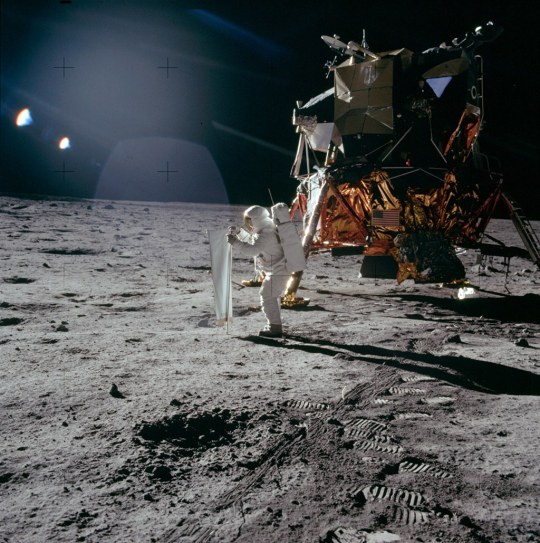
2023 July 29
Apollo 11: Catching Some Sun Image Credit: Apollo 11, NASA (Image scanned by Kipp Teague)
Explanation: Bright sunlight glints as long dark shadows mark this image of the surface of the Moon. It was taken fifty-four years ago, July 20, 1969, by Apollo 11 astronaut Neil Armstrong, the first to walk on the lunar surface. Pictured is the mission's lunar module, the Eagle, and spacesuited lunar module pilot Buzz Aldrin. Aldrin is unfurling a long sheet of foil also known as the Solar Wind Composition Experiment. Exposed facing the Sun, the foil trapped particles streaming outward in the solar wind, catching a sample of material from the Sun itself. Along with moon rocks and lunar soil samples, the solar wind collector was returned for analysis in earthbound laboratories.
∞ Source: apod.nasa.gov/apod/ap230729.html
310 notes
·
View notes
Text
HOW DID THE MOON FORM??
Blog#392
Saturday, April 13th, 2024.
Welcome back,
There used to be a number of theories about how the Moon was made and it was one of the aims of the Apollo program to figure out how we got to have our Moon,' says Sara.
Prior to the Apollo mission research there were three theories about how the Moon formed. The evidence returned from these missions gave us today's most widely accepted theory.
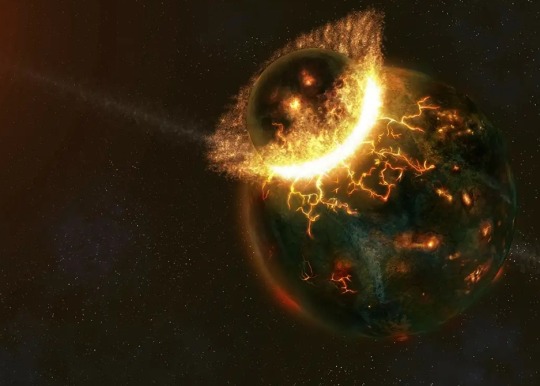
Capture theory suggests that the Moon was a wandering body (like an asteroid) that formed elsewhere in the solar system and was captured by Earth's gravity as it passed nearby.
The accretion hypothesis proposes that the Moon was created along with Earth at its formation.
The fission theory suggests Earth had been spinning so fast that some material broke away and began to orbit the planet.
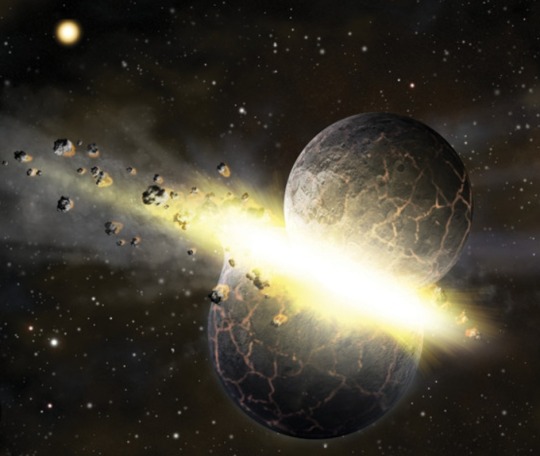
The giant-impact theory is most widely accepted today. This proposes that the Moon formed during a collision between the Earth and another small planet, about the size of the planet Mars. The debris from this impact collected in an orbit around Earth to form the Moon.
The Apollo missions brought back over a third of a tonne of rock and soil from the Moon. This provided some clues on how the Moon may have formed.

'When the Apollo rocks came back, they showed that the Earth and the Moon have some remarkable chemical and isotopic similarities, suggesting that they have a linked history,' says Sara.
'If the Moon had been created elsewhere and was captured by the Earth's gravity we would expect its composition to be very different from the Earth's.

'If the Moon was created at the same time, or broke off the Earth, then we would expect the type and proportion of minerals on the Moon to be the same as on Earth. But they are slightly different.'
The minerals on the Moon contain less water than similar terrestrial rocks. The Moon is rich in material that forms quickly at a high temperature.
'In the seventies and eighties there was a lot of debate which led to an almost universal acceptance of the giant impact model.'

Lunar meteorites are also an important source of data for studying the origins of the Moon.
'In some ways meteorites can tell us more about the Moon than Apollo samples because meteorites come from all over the surface of the Moon,' adds Sara, 'while Apollo samples come from just one place near the equator on the near side of the Moon.'
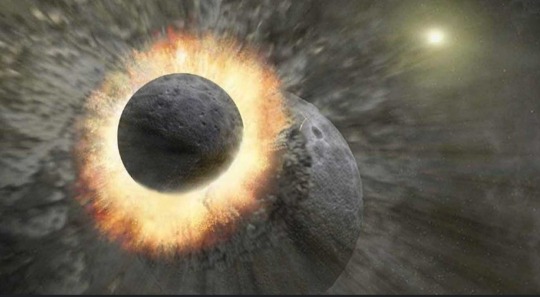
Before Earth and the Moon, there were proto-Earth and Theia (a roughly Mars-sized planet).
The giant-impact model suggests that at some point in Earth's very early history, these two bodies collided.
During this massive collision, nearly all of Earth and Theia melted and reformed as one body, with a small part of the new mass spinning off to become the Moon as we know it.
Scientists have experimented with modelling the impact, changing the size of Theia to test what happens at different sizes and impact angles, trying to get the nearest possible match.
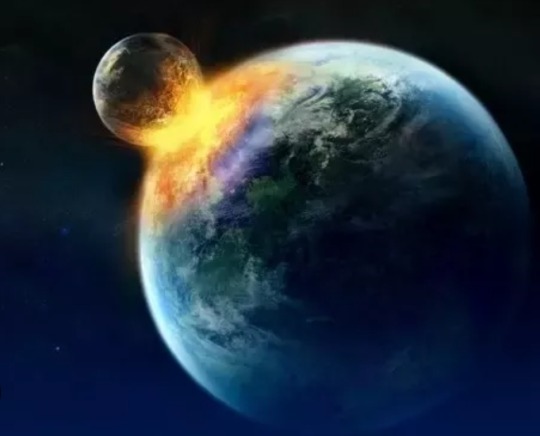
'People are now tending to gravitate towards the idea that early Earth and Theia were made of almost exactly the same materials to begin with, as they were within the same neighbourhood as the solar system was forming,' explains Sara.
'If the two bodies had come from the same place and were made of similar stuff to begin with, this would also explain how similar their composition is.'
Originally published on https://www.nhm.ac.uk
COMING UP!!
(Wednesday, April 17th, 2024)
"IS TIME AN ILLUSION??"
#astronomy#outer space#alternate universe#astrophysics#universe#spacecraft#white universe#space#parallel universe#astrophotography
59 notes
·
View notes
Text

Apollo 15 Commander Dave Scott on the Lunar Roving Vehicle during EVA 2. August 1, 1971.
The 7 hour and 12 minute EVA saw Apollo 15 astronauts Dave Scott and Jim Irwin visit Mons Hadley Delta. The crew collected numerous surface samples along the way, including sample 15415, which was dubbed the Genesis Rock. It was originally assumed that the sample was part of the Moon's primordial crust, but later analysis showed that the rock was about 4.1 billion years old, younger than the Moon itself.

Close-up of sample 15415 in the Lunar Receiving Laboratory.
The crew also attempted to drill samples for the heat-flow experiment at the ALSEP site, however the drill kept getting stuck and refused to advance any further. It was later discovered that the drill design was flawed. The crew then conducted a soil mechanics experiment by digging a trench and using a penetrometer to measure the strength of the lunar regolith. Finally, the crew set up the US flag before re-entering the Lunar Module for another sleep cycle.

Commander Dave Scott on the slope of Mons Hadley Delta. Lunar Roving Vehicle in the background.
Project Apollo Archive NASA 2, 3
32 notes
·
View notes
Text

Apollo 16: Exploring Plum Crater - June 7th, 1996.
"Apollo 16 spent three days on Earth's Moon in April of 1972. The fifth lunar landing mission out of six, Apollo 16 was famous for deploying and using an ultraviolet telescope as the first lunar observatory, and for collecting rocks and data on the mysterious lunar highlands. In the above picture, astronaut John W. Young photographs Charles M. Duke, Jr. collecting rock samples at the Descartes landing site. Duke stands by Plum Crater while the Lunar Roving Vehicle waits parked in the background. The Lunar Roving Vehicle allowed the astronauts to travel great distances to investigate surface features and collect rocks. High above, Thomas K. Mattingly orbits in the Command Module."
33 notes
·
View notes
Text

Flip it and reverse it: How the moon ‘turned itself inside out’
A study suggests that dense minerals (grey), left over from the Moon’s early history, are likely responsible for the satellite’s odd gravity.
Some 4.5 billion years ago, a small planet collided with Earth. This explosive impact, sometimes called the “big whack,” launched bits of molten debris into space. They eventually cooled and coalesced to form our Moon. This hypothesis is widely accepted among scientists, but many details remain fuzzy, including exactly how the lunar interior evolved, or why its current geology is so “lopsided.” Now, scientists may have put this long-standing mystery to rest. Using a combination of rock samples, satellite data, and computer simulations, researchers demonstrate how magma oceans on the surface of the young Moon crystallized into dense minerals like ilmenite. Because this layer was so heavy, huge slabs sank into the lunar interior, melted into the churning mantle, and eventually resurfaced as titanium-rich lava flows. “Our moon literally turned itself inside out,” planetary scientist and study co-author Jeff Andrews-Hanna said in a press release...
Read more: https://www.science.org/content/article/scienceadviser-vaccine-mrsa-flagging-bacterial-proteins-could-make-it-possible
22 notes
·
View notes
Text

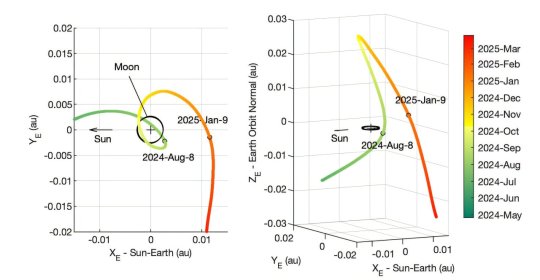
Study finds that Earth's small asteroid visitor is likely a chunk of moon rock
A near-Earth object was likely ejected into space after an impact thousands of years ago. Now it could contribute new insights to asteroid and lunar science.
The small near-Earth object 2024 PT5 captured the world's attention last year after a telescope discovered it lingering close to—but never orbiting—our planet for several months. The asteroid, which is about 33 feet (10 meters) wide, does not pose a hazard to Earth, but its orbit around the sun closely matches that of our planet, hinting that it may have originated nearby.
As described in a study published in the Astrophysical Journal Letters, researchers have collected further evidence of 2024 PT5 being of local origin: It appears to be composed of rock broken off from the moon's surface and ejected into space after a large impact.
"We had a general idea that this asteroid may have come from the moon, but the smoking gun was when we found out that it was rich in silicate minerals—not the kind that are seen on asteroids but those that have been found in lunar rock samples," said Teddy Kareta, an astronomer at Lowell Observatory in Arizona, who led the research.
"It looks like it hasn't been in space for very long, maybe just a few thousand years or so, as there's a lack of space weathering that would have caused its spectrum to redden."
The asteroid was first detected on Aug. 7, 2024, by the Sutherland, South Africa telescope of the University of Hawai'i's Asteroid Terrestrial-impact Last Alert System (ATLAS). Kareta's team then used observations from the Lowell Discovery Telescope and the NASA Infrared Telescope Facility (IRTF) at the Mauna Kea Observatory in Hawai'i to show that the spectrum of reflected sunlight from the small object's surface didn't match that of any known asteroid type; instead, the reflected light more closely matched rock from the moon.
Not (old) rocket science
A second clue came from observing how the object moves. Along with asteroids, Space Age debris, such as old rockets from historic launches, can also be found in Earth-like orbits.
The difference in their orbits has to do with how each type responds to solar radiation pressure, which comes from the momentum of photons—quantum particles of light from the sun—exerting a tiny force when they hit a solid object in space. This momentum exchange from many photons over time can push an object around ever so slightly, speeding it up or slowing it down. While a human-made object, like a hollow rocket booster, will move like an empty tin can in the wind, a natural object, such as an asteroid, will be much less affected.
To rule out 2024 PT5 being space junk, scientists at NASA's Center for Near Earth Object Studies (CNEOS), which is managed by the agency's Jet Propulsion Laboratory in Southern California, analyzed its motion. Their precise calculations of the object's motion under the force of gravity ultimately enabled them to search for additional motion caused by solar radiation pressure. In this case, the effects were found to be too small for the object to be artificial, proving 2024 PT5 is most likely of natural origin.
"Space debris and space rocks move slightly differently in space," said Oscar Fuentes-Muñoz, a study co-author and NASA postdoctoral fellow at JPL working with the CNEOS team. "Human-made debris is usually relatively light and gets pushed around by the pressure of sunlight. That 2024 PT5 doesn't move this way indicates it is much denser than space debris."
Asteroid lunar studies
The discovery of 2024 PT5 doubles the number of known asteroids thought to originate from the moon. Asteroid 469219 Kamo'oalewa was found in 2016 with an Earth-like orbit around the sun, indicating that it may also have been ejected from the lunar surface after a large impact. As telescopes become more sensitive to smaller asteroids, more potential moon boulders will be discovered, creating an exciting opportunity not only for scientists studying a rare population of asteroids, but also for scientists studying the moon.
If a lunar asteroid can be directly linked to a specific impact crater on the moon, studying it could lend insights into cratering processes on the pockmarked lunar surface. Also, material from deep below the lunar surface—in the form of asteroids passing close to Earth—may be accessible to future scientists to study.
"This is a story about the moon as told by asteroid scientists," said Kareta. "It's a rare situation where we've gone out to study an asteroid but then strayed into new territory in terms of the questions we can ask of 2024 PT5."
TOP IMAGE: Typically, asteroids—like the one depicted in this artist's concept—originate from the main asteroid belt between the orbits of Mars and Jupiter, but a small population of near-Earth objects may also come from the moon's surface after being ejected into space by an impact. Credit: NASA/JPL-Caltech
LOWER IMAGES: Researchers studying asteroid 2024 PT5 have plotted its looping motion on two graphs. To a trained eye, they show that the object never gets captured by Earth’s gravity but, instead, lingers nearby before continuing its orbit around the sun. Credit: NASA/JPL-Caltech
5 notes
·
View notes
Text
China to launch mission to moon’s “hidden” side
China would launch a robotic spacecraft on a round trip to the back side of the moon in the coming days, Reuters reported.
The journey will be the first of three technically challenging missions paving the way for the first landing of a Chinese crew and the establishment of a base at the lunar south pole.
Since the first Chang’e mission in 2007, named after the mythical Chinese moon goddess, China has made great strides in lunar exploration, narrowing the technological gap with the United States and Russia.
In 2020, China brought back samples from the near side of the moon for the first time in over forty years. The mission verified that the country could safely return an unmanned spacecraft to Earth from the lunar surface.
China is expected to launch Chang’e-6 this week using the 2020 mission’s backup spacecraft and collect soil and rocks from the moon’s back side, which is permanently facing away from Earth.
With no direct line of sight to Earth, Chang’e-6 will rely on the recently launched relay satellite orbiting the moon. The same satellite will support the unmanned Chang’e-7 and 8 missions in 2026 and 2028 respectively, when China will begin exploring the south pole in search of water and building a rudimentary outpost with Russia.
China aims to send its astronauts to the moon by 2030.
Read more HERE

#world news#world politics#news#china#china 2024#china news#chinese politics#astronaut#astronomy#astronews#sailor moon#hidden side
17 notes
·
View notes
Text

George W. Reed Jr. (September 25, 1920 - August 31, 2015) like his fellow scientists, was not at liberty to discuss, with any detail, his involvement in the project.
Born in DC, he spent his entire career as a chemist specializing in a variety of fields within the discipline. He received a BS and MS in Chemistry from Howard University. He completed his Ph.D. at the University of Chicago after his work with the Manhattan Project.
His training as both a nuclear and geo-chemist played important parts in his career. During WWII he and several other Black chemists worked at the University of Chicago Metallurgical Laboratory. Metallurgy chemists were crucial members of the Manhattan Project, namely because the two primary fuels for the atomic bombs were the metals uranium and plutonium. He worked on obtaining enough fissionable uranium to produce and sustain a nuclear reaction. His post-Manhattan project research continued in this area. He examined distinct patterns in radiation produced from uranium and plutonium at various stages. His work in uranium radiation had an impact on the construction of the atomic bomb.
He held several positions and worked outside of nuclear chemistry, most notably with the Meteoritical Society. He was on the lunar sample planning team with the National Aeronautics and Space Administration. He was allowed to analyze the sample of moon rock in a nuclear reactor; he concluded that the rock contained minerals not found on Earth.
He held positions in the chemistry division of the Argonne National Laboratory, first as an associate chemist and as a senior scientist beginning in 1968.
He married Selina Edwards and they had four children. #africanhistory365 #africanexcellence
6 notes
·
View notes
Text


55 years ago… 1969, June 25 Final lunar EVA training days for the Apollo 11 Moonwalkers with Edwin Buzz Aldrin in full spacesuit wearing a NASA-issued Omega Speedmaster chronograph on long black velcro strap on the righthand wrist. On launch day, Apollo 11 Lunar Module Pilot Edwin "Buzz" Aldrin wore his Speedmaster on the lefthand wrist (Armstrong and Collins on the righthand wrist). The Apollo 11 "Eagle" stayed 21.5 hours on the Moon and the Moonwalkers performed a 2 hours 31 minutes long lunar EVA collecting 21 kilograms of lunar rocks & samples. Amrstrong left his NASA n° 46 in the Lunar Lander as a backup time piece. During the Apollo 11 lunar EVA, Aldrin wore the NASA n° 43 Speedmaster on the righthand wrist, afterwards not noticed by Omega marketing who added an extra watch at his lefthand wrist in the black & white drawing. Anno 2024 only 4 of the 12 are still with us; Edwin Aldrin (A11), David Scott (A15), Charles Duke (A16) and Harrison Schmitt (A17). (Photos: NASA/Omega/MoonwatchUniverse)
#Apollo#Astronaut#321#chronograph#Moonwatch#MoonwatchUniverse#NASA#Omega#Speedmaster#Speedytuesday#spaceflight#Moon#Mond#Maan#Mjesec#Luna#Lune#Zulu time#Aldrin
8 notes
·
View notes
Text
China continues to take great strides as part of its goal to become a superpower in space and a direct competitor with NASA. In addition to its proposed expansion of the Tiangong space station and the creation of the International Lunar Research Station (ILRS), China is also planning on sending crewed missions to Mars in the coming decade. In preparation for the arrival of taikonauts on the Red Planet, China is gearing up to return samples of Martian soil and rock to Earth roughly two years ahead of the proposed NASA-ESA Mars Sample Return (MSR). This mission will be the third in the China National Space Administration's (CNSA) Tianwen program (Tianwen-3) and will consist of a pair of launches in 2028 that will return samples to Earth in July 2031.
Continue Reading.
130 notes
·
View notes
Text
Let's talk science. Here are my top 10 reasons why I reject the Nation of Islam's belief that the Moon was made 66 trillion years by an evil Black Scientist, who dug near the center of the Earth, filling it with dynamite and separating the Earth from the Moon.
1. Due the extreme temperature and pressure, it's virtually impossible to dig anywhere near the Earth's core. We barely had the technology to drill 7.5 miles below the Earth's surface before the drills overheated and broke. For the NOI Moon deportation belief to be true, without any empirical evidence, we would have to ASSUME that the technology existed.
2. Radiometric dating of the Earth, Moon, Mars, meteorites, in fact most of the material in Solar System, dates back to roughly 4.5 billion years ago. This is one reason scientists think our Solar System formed from the same collapsed cloud of gas and dust about 4.6 billion years ago. For the NOI Moon deportation belief to be true, without any empirical evidence, we would have to ASSUME the Solar System is far older ("trillions of years ") than the data show.
3. Archaeological and genetic evidence suggests the age of anatomically modern Homo sapiens is about 200,000 to 300,000 years old. For the NOI Moon deportation belief to be true, without any genetic or fossil evidence, we would have to ASSUME that humans have existed for trillions of years.
4. The object that impacted the Earth 66 million years ago, partly responsible for the extinction of the dinosaurs, released more kinetic energy than almost any other event in Earth's history. The Chicxulub meteor imoact released 100 Teratons of TNT. But it was not sufficient to overcome the gravitational binding energy between the Earth and the Moon.
In contrast, the energy released by the Mars-size bollide ("Theia") that separated Luna from Earth was equivalent to 8,000 Teratons. This means it was about 80 times more energetic. 1 Teraton is equal to the energy released when detonating 1 trillion tons of TNT. So, 8,000 Teratons would be the energy equivalent of 8,000 trillion tons of TNT. That's the weight of about 50,000 Mt. Everests.
For the NOI Moon deportation belief to be true, without any empirical evidence, we would have to ASSUME someone had the expertise, equipment, materials, manpower and facilities to transport and store this amount of TNT. Even then, it would take several decades (or longer) to produce.
5. Gunpowder is a mixture of potassium nitrate, charcoal and sulfur. Dynamite is primarily nitroglycerin and some sort of absorbent material (like clayshells, or sawdust). Moondust, on the other hand, is composed of silicon dioxide glass, plus iron, magnesium, calcium and other trace materials. No lunar rocks or soil samples taken from the Moon contained any trace of explosives, gunpowder, or any artificial, man-made substances whatsoever. For the NOI Moon deportation belief to be true, without any empirical evidence, we would have to ASSUME either a.) traces of gunpowder does exist in the Luna rock and soil, we just haven't detected it yet or b.) scientists have discovered but there is a global conspiracy to conceal it.
6. The impact craters from comets and asteroids bombarding the lunar surface have a frequency and distribution that's consistent with a 4.5 billion year model of the Solar System, not a 66 trillion one.
7. Tidal forces, from the gravitational interactions between Earth and Moon, are causing the Moon to recede from the Earth at a rate of roughly 1.5 inches per year. This is approximately the rate our fingernails grow.
Over the course of trillions of years, the gravitational forces would have weakened significantly as the distance between the Earth and the Moon increased far beyond what it currently is today. Eventually, this weakening of gravitational forces would have lead to a gradual reduction in the rate of tidal transfer of angular momentum. However, the geological records (preserved in ancient tidal rhythmites in sedimentary rocks formations) do not reflect trillions of years. We also put retroreflectors on the Moon during the Apollo missions, so we can use laser ranging to measure the distance from Earth to Moon with precision and the measurements are consistent with a theoretical model of the Moon being 4.5 billion years, not 66 trillion years.
8. Our Sun is a yellow dwarf. A G-type main-sequence star and is about 4.6 billion years old. It's age was measured by radiometric dating of meteorites, isotopic information, and from observing the life cycle of other stars in the Universe. Based on our understanding of stellar evolution, the Sun will exhaust its hydrogen fuel in about 5 billion years and become a red giant star.
If the Sun were "trillions" of years old, it would have already exhausted its hydrogen fuel, travelled through all of the stages of stellar evolution, from yellow dwarf to red giant to planetary nebula to white dwarf and, finally, a cold, dark object called a Black dwarf.
9. If the Earth were "trillions" of years old, then we would see evidence of that in the fossil record, archeology, geology, climate, ocean sediments, genetic, paleontology, etc. We don't. Everything we discover is consistent with a 4.5 billion year old planet.
10. Cosmic Microwave Background Radiation, the redshift of galaxies, the fact that the farther away a galaxy is from Earth, the faster it appears to be moving away (Hubble's Law), and many other forms of observational evidence (gravitational lensing, stellar evolution, nucleosynthesis) serve as signatures of the universe expanding from a small, hot dense state about 13.8 billion years ago. We would not expect to see, nor could we explain, these phenomena, if the universe was trillions of years old.
By Supreme Scientist Allah (facebook)
#nation of gods and earths#five percent nation#supreme mathematics#allah school in mecca#hip hop#5% nation of gods and earths#black women#father allah#nation of islam#Elijah Muhammad#black people#scientist#scientific research#black men#black owned businesses#underground hip hop#rappers
8 notes
·
View notes